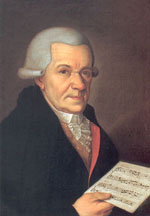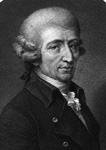 I’ve been working with our church choir on “Sing a New Song” by Michael Haydn. It was part of the church music library and threw me a little off guard. The name was Michael Haydn, but the sound was semi-baroque – but more contemporary sounding than JS Bach. It reminded me more of the sound of Bach’s sons like CPE Bach. To my ears a kind of “baroque light” sound.
I’ve been working with our church choir on “Sing a New Song” by Michael Haydn. It was part of the church music library and threw me a little off guard. The name was Michael Haydn, but the sound was semi-baroque – but more contemporary sounding than JS Bach. It reminded me more of the sound of Bach’s sons like CPE Bach. To my ears a kind of “baroque light” sound.
This may seem like a small incident to you, but to me it was a big red flag. Have my ears deceived me, do I not understand Baroque music like I thought I did? It was a little too contemporary to be Baroque, and a little too Baroque to be contemporary. I had assumed Michael Haydn was a contemporary composer writing in Baroque style, but couldn’t get over how authentic some parts sounded.
So the hunt begins – Yes, the music WAS written in the 18th century, but who in the heck is Michael Haydn. Well, I’m showing a lapse in my music knowledge when I admit that I did not know Franz Joseph Haydn had a brother who was also a composer: Michael Haydn.
The happy ending to all this is I can rest easy my ears are still true. YES, it is music with a Baroque feel but not technically of the Baroque period (which ended in 1750), and YES it is authentic classical music – not a neo-classical re-creation. I don’t know more of his music to tell you if it’s representative of his style – but on this particular piece if I put down the composer as CPE Bach, I would be surprised if most would know the difference on hearing the piece for the first time.
So the next interesting question is – Like Salieri may have been the great remembered composer if Mozart had not lived; Would Michael have been the great remembered composer if Franz Joseph had not lived….or did Franz Joseph’s music help preserve the longevity of brother Michael’s compositions?
If you have the answer, I’d love for you to post it here.
And of course the interesting comment that history has on all this. Bach’s sons music was considered “modern” in the 18th century, and JS Bach’s music sounded old fashioned to ears at that time. They called JS the “old Bach”. But to our ears today, JS Bach’s music is the one that usually moves us most, is most “authentic” – and his sons music is….well….a little more like a jingle. His sons music lacks the depth of the old master. I would guess that Michael Haydn’s music was very successful in his day, like CPE Bach – but that time has eroded his music’s power just a wee bit. I’m guessing it stands as “good” baroque music, but not masterpieces. Please correct me, just my intuitive guesses.
Biography of Michael Haydn
Johann Michael Haydn September 14, 1737 August 10, 1806 was an Austriancomposer, the younger brother of (Franz) Joseph Haydn.
Michael Haydn was born in 1737 in the Austrian village of Rohrau near the Hungarian border. His father was Matthias Haydn, a wheelwright who also served as “Marktrichter”, an office akin to village mayor. Haydn’s mother, the former Maria Koller, had previously worked as a cook in the palace of Count Harrach, the presiding aristocrat of Rohrau. Neither parent could read music. However, Matthias was an enthusiastic folk musician, who during the journeyman period of his career had taught himself to play the harp.
Michael Haydn, like his brother Joseph, was a chorister at St Stephen’s in Vienna. Shortly after leaving the choir-school, he was appointed Kapellmeister at Großwardein and later, in 1762, at Salzburg. The latter office he held for forty-three years, during which time he wrote over 360 compositions for the church and much instrumental music. He was an intimate friend of Mozart, who had a high opinion of his work, and the teacher of Carl Maria von Weber.
Haydn’s sacred choral works are generally regarded as being his most important, including the Requiem pro defuncto Archiepiscopo Sigismundo (Requiem for the death of Archbishop Siegmund) in C minor, which has greatly influenced the Requiem by Mozart,Missa Hispanica (which he exchanged for his diploma at Stockholm), a Mass in D minor, a Lauda Sion, and a set of graduals, forty-two of which are reprinted in Anton Diabelli’s Ecciesiaslicon. He was also a prolific composer of secular music, including forty symphonies, a number of concerti and chamber music including a string quintet in C major which was once thought to have been by his brother Joseph.
Michael Haydn was the victim of another case of posthumous mistaken identity: for many years, the piece which is now known as Michael Haydn’s Symphony No. 26 was thought to be Mozart’s Symphony No. 37 and assigned K. 444. The confusion arose because an autograph was discovered which had the opening movement of the symphony in Mozart’s hand, and the rest in somebody else’s. It is now thought that Mozart had composed a new slow opening movement for reasons unknown, but the rest of the work is known to be by Michael Haydn. The piece, which had been quite widely performed as a Mozart symphony, has been performed considerably less often since this discovery in 1907.
Some of Haydn’s works are referred to by Perger numbers, from the thematic catalog of his works compiled by Lothar Perger in 1907.
Franz Joseph Haydn 1732-1809
“Papa” Haydn
